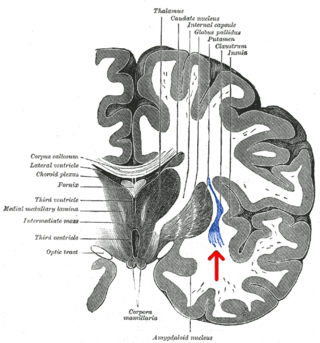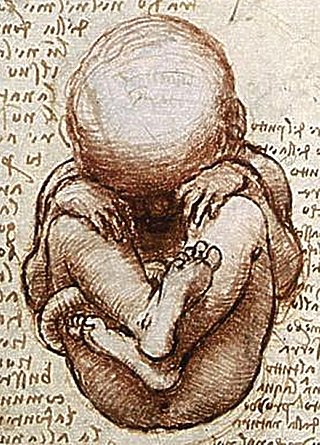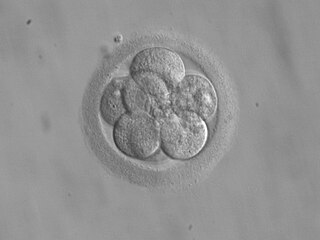Related Research Articles

The central nervous system (CNS) is the part of the nervous system consisting primarily of the brain and spinal cord. The CNS is so named because the brain integrates the received information and coordinates and influences the activity of all parts of the bodies of bilaterally symmetric and triploblastic animals—that is, all multicellular animals except sponges and diploblasts. It is a structure composed of nervous tissue positioned along the rostral to caudal axis of the body and may have an enlarged section at the rostral end which is a brain. Only arthropods, cephalopods and vertebrates have a true brain, though precursor structures exist in onychophorans, gastropods and lancelets.

The cerebral cortex, also known as the cerebral mantle, is the outer layer of neural tissue of the cerebrum of the brain in humans and other mammals. It is the largest site of neural integration in the central nervous system, and plays a key role in attention, perception, awareness, thought, memory, language, and consciousness. The cerebral cortex is the part of the brain responsible for cognition.

The thalamus is a large mass of gray matter on the lateral walls of the third ventricle forming the dorsal part of the diencephalon. Nerve fibers project out of the thalamus to the cerebral cortex in all directions, known as the thalamocortical radiations, allowing hub-like exchanges of information. It has several functions, such as the relaying of sensory and motor signals to the cerebral cortex and the regulation of consciousness, sleep, and alertness.
Blindsight is the ability of people who are cortically blind to respond to visual stimuli that they do not consciously see due to lesions in the primary visual cortex, also known as the striate cortex or Brodmann Area 17. The term was coined by Lawrence Weiskrantz and his colleagues in a paper published in a 1974 issue of Brain. A previous paper studying the discriminatory capacity of a cortically blind patient was published in Nature in 1973. The assumed existence of blindsight is controversial, with some arguing that it is merely degraded conscious vision.

The brain is the central organ of the human nervous system, and with the spinal cord, comprises the central nervous system. It consists of the cerebrum, the brainstem and the cerebellum. The brain controls most of the activities of the body, processing, integrating, and coordinating the information it receives from the sensory nervous system. The brain integrates the instructions sent to the rest of the body. The brain is contained in, and protected by, the skull of the head.

The claustrum is a thin sheet of neurons and supporting glial cells in the brain, that connects to the cerebral cortex and subcortical regions including the amygdala, hippocampus and thalamus. It is located between the insular cortex laterally and the putamen medially, encased by the extreme and external capsules respectively. Blood to the claustrum is supplied by the middle cerebral artery. It is considered to be the most densely connected structure in the brain, and thus hypothesized to allow for the integration of various cortical inputs such as vision, sound and touch, into one experience. Other hypotheses suggest that the claustrum plays a role in salience processing, to direct attention towards the most behaviorally relevant stimuli amongst the background noise. The claustrum is difficult to study given the limited number of individuals with claustral lesions and the poor resolution of neuroimaging.

Antonio Damasio is a Portuguese neuroscientist. He is currently the David Dornsife Chair in Neuroscience, as well as Professor of Psychology, Philosophy, and Neurology, at the University of Southern California, and, additionally, an adjunct professor at the Salk Institute. He was previously the chair of neurology at the University of Iowa for 20 years. Damasio heads the Brain and Creativity Institute, and has authored several books: his work, Self Comes to Mind: Constructing the Conscious Brain (2010), explores the relationship between the brain and consciousness. Damasio's research in neuroscience has shown that emotions play a central role in social cognition and decision-making.
In philosophy and neuroscience, neuroethics is the study of both the ethics of neuroscience and the neuroscience of ethics. The ethics of neuroscience concerns the ethical, legal, and social impact of neuroscience, including the ways in which neurotechnology can be used to predict or alter human behavior and "the implications of our mechanistic understanding of brain function for society... integrating neuroscientific knowledge with ethical and social thought".

The reticular formation is a set of interconnected nuclei in the brainstem that spans from the lower end of the medulla oblongata to the upper end of the midbrain. The neurons of the reticular formation make up a complex set of neural networks in the core of the brainstem. The reticular formation is made up of a diffuse net-like formation of reticular nuclei which is not well-defined. It may be seen as being made up of all the interspersed cells in the brainstem between the more compact and named structures.
A gamma wave or gamma rhythm is a pattern of neural oscillation in humans with a frequency between 30 and 100 Hz, the 40 Hz point being of particular interest. Gamma rhythms are correlated with large-scale brain network activity and cognitive phenomena such as working memory, attention, and perceptual grouping, and can be increased in amplitude via meditation or neurostimulation. Altered gamma activity has been observed in many mood and cognitive disorders such as Alzheimer's disease, epilepsy, and schizophrenia.

In neuroanatomy, thalamocortical radiations, also known as thalamocortical fibers, are the efferent fibers that project from the thalamus to distinct areas of the cerebral cortex. They form fiber bundles that emerge from the lateral surface of the thalamus.
Prenatal perception is the study of the extent of somatosensory and other types of perception during pregnancy. In practical terms, this means the study of fetuses; none of the accepted indicators of perception are present in embryos. Studies of this type inform the abortion controversy, along with certain related pieces of legislation in countries affected by that debate. As of 2022, there is not any scientific consensus on whether a fetus can feel pain.
The philosophical aspects of the abortion debate are logical arguments that can be made either in support of or in opposition to abortion. The philosophical arguments in the abortion debate are deontological or rights-based. The view that all or almost all abortion should be illegal generally rests on the claims that (1) the existence and moral right to life of human beings begins at or near conception-fertilization; that (2) induced abortion is the deliberate and unjust killing of the embryo in violation of its right to life; and that (3) the law should prohibit unjust violations of the right to life. The view that abortion should in most or all circumstances be legal generally rests on the claims that (1) women have a right to control what happens in and to their own bodies; that (2) abortion is a just exercise of this right; and that (3) the law should not criminalize just exercises of the right to control one's own body and its life-support functions.

Fetal movement refers to motion of a fetus caused by its own muscle activity. Locomotor activity begins during the late embryological stage and changes in nature throughout development. Muscles begin to move as soon as they are innervated. These first movements are not reflexive, but arise from self-generated nerve impulses originating in the spinal cord. As the nervous system matures, muscles can move in response to stimuli.
The development of the nervous system in humans, or neural development, or neurodevelopment involves the studies of embryology, developmental biology, and neuroscience. These describe the cellular and molecular mechanisms by which the complex nervous system forms in humans, develops during prenatal development, and continues to develop postnatally.

The neural correlates of consciousness (NCC) are the minimal set of neuronal events and mechanisms sufficient for the occurrence of the mental states to which they are related. Neuroscientists use empirical approaches to discover neural correlates of subjective phenomena; that is, neural changes which necessarily and regularly correlate with a specific experience. The set should be minimal because, under the materialist assumption that the brain is sufficient to give rise to any given conscious experience, the question is which of its components are necessary to produce it.

The beginning of human personhood is the moment when a human is first recognized as a person. There are differences of opinion about the precise time when human personhood begins and the nature of that status. The issue arises in a number of fields, including science, religion, philosophy, and law, and is most acute in debates about abortion, stem cell research, reproductive rights, and fetal rights.

Sexual orientation is an enduring pattern of romantic or sexual attraction to persons of the opposite sex or gender, the same sex or gender, or to both sexes or more than one gender, or none of the aforementioned at all. The ultimate causes and mechanisms of sexual orientation development in humans remain unclear and many theories are speculative and controversial. However, advances in neuroscience explain and illustrate characteristics linked to sexual orientation. Studies have explored structural neural-correlates, functional and/or cognitive relationships, and developmental theories relating to sexual orientation in humans.

The parabrachial nuclei, also known as the parabrachial complex, are a group of nuclei in the dorsolateral pons that surrounds the superior cerebellar peduncle as it enters the brainstem from the cerebellum. They are named from the Latin term for the superior cerebellar peduncle, the brachium conjunctivum. In the human brain, the expansion of the superior cerebellar peduncle expands the parabrachial nuclei, which form a thin strip of grey matter over most of the peduncle. The parabrachial nuclei are typically divided along the lines suggested by Baxter and Olszewski in humans, into a medial parabrachial nucleus and lateral parabrachial nucleus. These have in turn been subdivided into a dozen subnuclei: the superior, dorsal, ventral, internal, external and extreme lateral subnuclei; the lateral crescent and subparabrachial nucleus along the ventrolateral margin of the lateral parabrachial complex; and the medial and external medial subnuclei

Fetal electroencephalography, also known as prenatal EEG includes any recording of electrical fluctuations arising from the brain of a fetus. Doctors and scientists use EEGs to detect and characterize brain activity, such as sleep states, potential seizures, or levels of a coma. EEG captures the electrical activity in the vicinity of the recording electrodes. The majority of the neural electrical activity arises from the flow of current from the cell bodies of pyramidal neurons to their apical dendrites, which become depolarized by excitatory inputs from other neurons. To record the most accurate signals, scientists try to minimize the distance between the recording electrode and the neural activity that they want to detect. Given the difficulty of attaching electrodes to a fetus inside a uterus, doctors and scientists use a variety of techniques to record fetal brain activity.
References
- 1 2 3 "Crashing the boards: Neuroscientist Maureen Condic brings a different voice to NSF oversight body". Science | AAAS. 2018-11-25. Retrieved 2018-12-01.
- 1 2 Neumann, Erik. "Utah Professor Tapped To Oversee National Science Foundation, Widely Cited By Anti-Abortion Groups" . Retrieved 2018-12-01.
- 1 2 "White House Names University of Utah Bioethicist Maureen Condic to Six-Year Term on National Science Board - Utah Business". Utah Business. 2018-11-08. Retrieved 2018-12-01.
- ↑ University, Catholic. "Welcoming Dr. H. Joseph Yost as Senior Vice Provost for Research". The Catholic University of America. Retrieved 2025-01-03.
- ↑ "Condic ml and spinal - Search Results - PubMed".
- ↑ Condic, Maureen L. (2016). "Determination of Death: A Scientific Perspective on Biological Integration". Journal of Medicine and Philosophy. 41 (3): 257–278. doi:10.1093/jmp/jhw004. PMC 4889815 . PMID 27075193.
- ↑ Condic, Maureen L.; Harrison, Donna (2018-06-18). "Treatment of an Ectopic Pregnancy". The Linacre Quarterly. 85 (3): 241–251. doi:10.1177/0024363918782417. ISSN 0024-3639. PMC 6161225 . PMID 30275609.
- ↑ Condic, Dr Maureen L. (2009-04-16). "Does Research Really Need Human Embryos and Cloning?". The Daily Beast. Retrieved 2018-12-01.
- ↑ Condic, Maureen L. (2014-04-15). "Totipotency: What It Is and What It Is Not". Stem Cells and Development. 23 (8): 796–812. doi:10.1089/scd.2013.0364. ISSN 1547-3287. PMC 3991987 . PMID 24368070.
- ↑ Condic, Maureen L. (2001). "Adult Neuronal Regeneration Induced by Transgenic Integrin Expression". The Journal of Neuroscience. 21 (13): 4782–4788. doi:10.1523/JNEUROSCI.21-13-04782.2001. PMC 6762359 . PMID 11425905.
- ↑ Condic, Samuel B.; Condic, Maureen L. (29 June 2018). Human Embryos, Human Beings: A Scientific and Philosophical Approach. CUA Press. ISBN 978-0813230238.
- ↑ Condic, Maureen L. (2020). Untangling Twinning: What Science Tells Us about the Nature of Human Embryos. University of Notre Dame Press. ISBN 978-0268107055.
- ↑ "APPENDIX A Affidavit of Dr. Maureen L. Condic, Ph.D. STATE OF". studylib.net. Retrieved 2018-12-01.
- ↑ Biblical Creation & Apologetics Ministries (2017-04-12), Dr Maureen Condic Congressional Testimony: Fetal Pain at 8 Weeks... , retrieved 2018-12-01
- ↑ "Dobbs Amicus Brief" (PDF). Charlotte Lozier Institute. Retrieved 4 August 2021.
- 1 2 3 Lutkenhoff, Evan S.; Chiang, Jeffrey; Tshibanda, Luaba; Kamau, Evelyn; Kirsch, Murielle; Pickard, John D.; Laureys, Steven; Owen, Adrian M.; Monti, Martin M. (July 2015). "Thalamic and extrathalamic mechanisms of consciousness after severe brain injury: Brain Injury and Consciousness". Annals of Neurology. 78 (1): 68–76. doi:10.1002/ana.24423. hdl: 2268/183269 . PMID 25893530. S2CID 10774807.
- ↑ Fuller, Patrick; Sherman, David; Pedersen, Nigel P.; Saper, Clifford B.; Lu, Jun (2011-04-01). "Reassessment of the structural basis of the ascending arousal system". The Journal of Comparative Neurology. 519 (5): 933–956. doi:10.1002/cne.22559. PMC 3119596 . PMID 21280045.
- ↑ Padilla, Nelly; Lagercrantz, Hugo (May 2020). "Making of the mind". Acta Paediatrica. 109 (5): 883–892. doi: 10.1111/apa.15167 . ISSN 0803-5253. PMID 31922622. S2CID 210133737.
- ↑ https://www.supremecourt.gov/DocketPDF/19/19-1392/185364/20210729171818898_CondicCLI%20Amicus%20Brief%20Final.pdf [ bare URL PDF ]
- ↑ Moser, Julia; Schleger, Franziska; Weiss, Magdalene; Sippel, Katrin; Semeia, Lorenzo; Preissl, Hubert (2021-06-01). "Magnetoencephalographic signatures of conscious processing before birth". Developmental Cognitive Neuroscience. 49: 100964. doi:10.1016/j.dcn.2021.100964. ISSN 1878-9293. PMC 8163957 . PMID 34023644. S2CID 235167579.
- ↑ "St. Albert Award Archive".
- ↑ Institute, Social Trends. "Maureen Condic | Social Trends Institute". socialtrendsinstitute.org. Retrieved 2018-12-01.